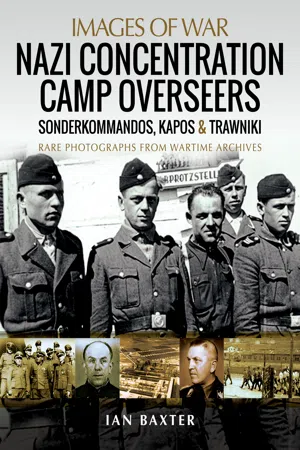![]()
Chapter One
Prelude to Genocide
It was as far back as March 1933 that the first concentration camp was built by the Nazis, called Dachau. The camp was a far cry from what later characterised the death camps, but even from the beginning its commandant, SS-Brigadeführer Theodor Eicke, was determined to bring hatred and brutality to its inmates. Eicke was the architect, builder, and director of the concentration camp system and looked upon Dachau as a prototype for the concentration camps that followed. Its organisation, layout and construction were developed and ordered by Eicke.
To staff the camps Eicke requested a permanent unit that would be subordinate only to him: the SS-Wachverbände (SS guard groups) were formed. The Wachvebände were independent units within the SS, with their own ranks and command structure. The guards were required to follow Eicke’s demands with blind obedience.
By August 1937 the Dachau, Sachsenhausen, Buchenwald and Ravensbrück camps were operating in Germany. The next year, following the Anschluss, Eicke oversaw the building of Mauthausen in Austria.
Each camp was commanded by a Kommandant, who ran the camp with the aid of an adjutant and his command staff. Supervision of the inmates was the responsibility of the Rapportführer, who supervised the daily roll call and daily schedule. The prisoner barracks were operated by a Blockführer, who had one to two squads of SS soldiers to watch over the prisoners.
A period of unrestrained terror followed the invasion of Poland, particularly in what were known as the incorporated territories of Lublin and parts of the provinces of Warsaw and Krakow. In 1940 this area became known as the ‘General Government’. It was the dumping ground for all undesirables and enemies of the state. The German authorities established camps in Poland where these undesirables could be incarcerated. It was envisaged that these Poles would be a slave labour force.
Further concentration camps were erected, such as Auschwitz-Birkenau and appeals were made for staff.
These helpers – Hiwis (an abbreviation of Hilfswilliger, volunteer) were far more numerous than the SS personnel. They mainly consisted of Sonderkommandos (special units), Kapos (prisoner functionaries) and Trawniki men (prisoners from East and Central European countries recruited to work for the SS).
A portrait photograph of SS-Obergruppenführer Theodor Eicke. Eicke had been made commandant of Dachau concentration camp in June 1933, and became a major figure in the SS. He was regarded the architect, builder, and director of the concentration camp system and ruled it with an iron fist. It was Eicke that introduced the infamous blue and white striped pyjamas that the inmates wore which came to symbolize the Nazi concentration camps across Europe. While it was Himmler who was ultimately in charge of the concentration camp system, it was Eicke who was the driving force inside the camps.
Aerial view of the Dachau concentration camp. Dachau was located on the grounds of an abandoned munitions factory near the medieval town of Dachau, 10 miles north-west of Munich. It was the first regular concentration camp established by the Nazis and was regarded by Himmler as the first camp for political opponents who were seen as an imminent threat to the new German government. Dachau was established on 20 March 1933. It served as a prototype for the concentration camps that followed. Its basic organisation, layout and construction were developed and ordered by SS-Obergruppenführer Theodor Eicke. (USHMM, Ray Schmidt)
View of a wall and guard tower at Dachau. Life for the prisoners inside Dachau was brutal. The SS guards followed Eicke with blind obedience. By drilling his SS guards to hate the prisoners, they were able to mete out severe punishments. (USHMM, William and Dorothy McLaughlin)
Group portrait of SS personnel in the Buchenwald concentration camp. Buchenwald was established in July 1937. It was one of the first and the largest of the concentration camps built in Germany. Many actual or suspected communists were the first to be imprisoned there. (USHMM, Robert A. Schmuhl)
High ranking SS officials on an inspection tour of the Mauthausen concentration camp. Pictured in the front row from left to right are Ernst Kaltenbrunner, Franz Ziereis, Heinrich Himmler, Karl Chmielewski, and August Eigruber. At the far right in the second row is George Bachmayer. The Mauthausen main camp operated from the time of the Anschluss, when Austria was united with the Reich on 8 August 1938. Mauthausen and its subcamps soon become one of the largest labour camp comp...





